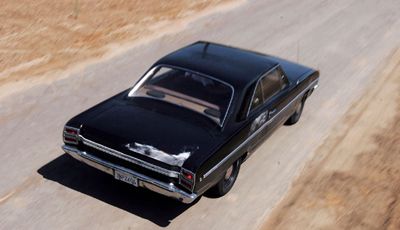
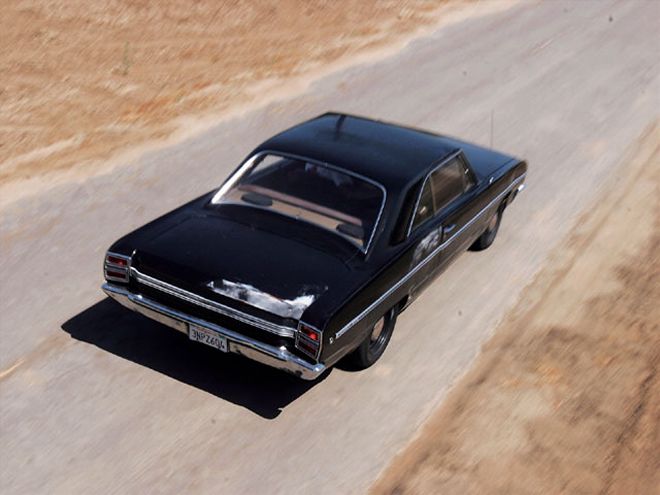
Now I've got a little more respect for Chrysler's six-cylinder A-body. Lightweight, and able to cruise all day on a sniff of gasoline, my '68 Dart will effortlessly fly down the highway at 85 mph. It's surprising that it runs so comfortably at speed, though it takes a while getting there. For now, I can live with that, but what's more threatening is that it takes even longer getting back down from speed. Equipped with bottom-of-the-barrel 9-inch drums at all four corners, the situation is bad enough. But even more worrisome is the leaky master cylinder. Overall, the braking system doesn't qualify as marginal, and not knowing whether or not there will be pedal is just plain risky. Fighting SoCal traffic where lanes can choke from an 80-mph flow to a dead halt makes the situation an accident waiting to happen.
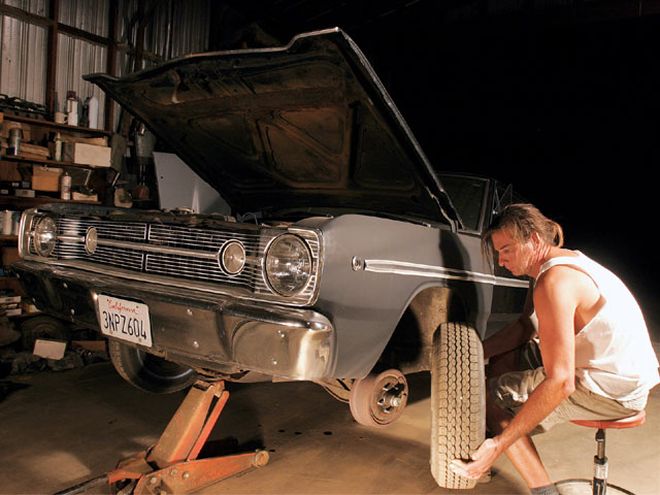 Hiding behind the stock 13-inch wheels is a set of tiny, 9-inch drum brakes. Getting to a halt with these can be a dangerous game, particularly when you need them the most.
Hiding behind the stock 13-inch wheels is a set of tiny, 9-inch drum brakes. Getting to a halt with these can be a dangerous game, particularly when you need them the most.
Obviously, the right choice is to upgrade. Here, several possibilities are open to the Mopar A-body enthusiast. An OEM upgrade is one choice, with factory cars optionally equipped with Kelsey Hayes discs until 1972, and the Bendix single-piston system from 1973 forward. The '73-and-later system is the most popular, though this braking system was a factory adaptation of B- and E-body components. Major drawbacks with the common late-factory disc brakes are a substantial 1.5-inch increase in track width, limiting tire clearance and wheel offset, and a need to change balljoints, upper A-arms, and spindles in earlier cars. That's enough to take the shine off the prospects for junkyard scrounging.
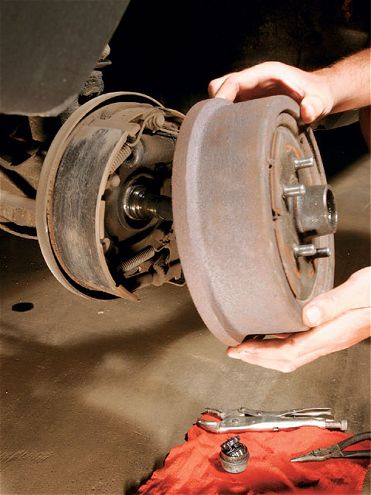 Chrysler used different spindles for 9-inch, 10-inch, and factory disc brake cars of this vintage, and yet another spindle for '73-and-later A-bodies.
Chrysler used different spindles for 9-inch, 10-inch, and factory disc brake cars of this vintage, and yet another spindle for '73-and-later A-bodies.
A better solution is an aftermarket system with all the components for a direct conversion to your existing drum brake spindle. Wilwood offers kits to convert either the 9-inch or 10-inch factory drums (the spindles are different between the two) to their lightweight 10.75-inch discs. Since the Wilwood hubs are designed to work with the original spindle, the conversion can be accomplished without removing or replacing the balljoints, control arms, or spindles. All it takes is removal of the factory drum setup and bolting on the Wilwood discs and calipers, making this an easy and direct swap.
In addition to the disc conversion, it was high time to pitch our leaky drum-brake master cylinder. Wilwood carries the lightweight late-model OEM Mopar aluminum master cylinder, which has become popular as a universal conversion piece. Rather than picking up a questionable parts-house re-man master, the Wilwood master cylinder offers the peace of mind that comes with an all-new unit-and, unlike most re-mans, also comes with the required reservoir. To complete the upgrade, we added a Wilwood adjustable proportioning valve, a braided-steel brake line kit, and a few bottles of Wilwood's special high-temp brake fluid to our shopping list.
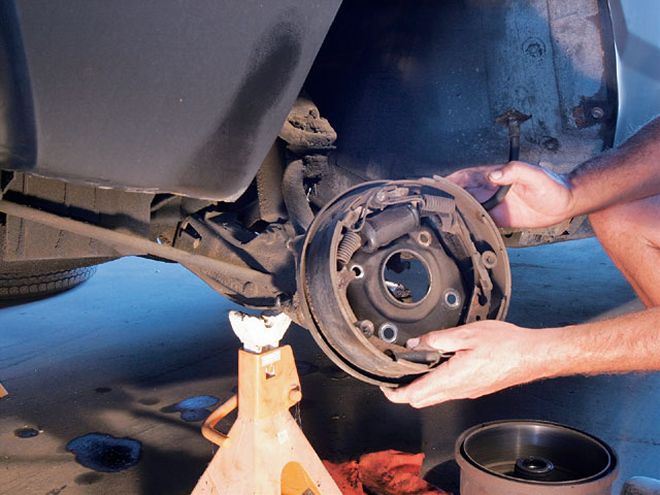 To swap the brakes, the weight of the car must be supported by a jackstand under the lower control arm. After removing the brake hose and drum, four bolts are all it takes to pull the drum setup.
To swap the brakes, the weight of the car must be supported by a jackstand under the lower control arm. After removing the brake hose and drum, four bolts are all it takes to pull the drum setup.
Without a doubt, the Wilwood components deliver. Right from the start, the first-rate machining quality, detailed instructions, and completeness of the package offered proof that we were dealing with a top-tier manufacturer. The installation presented no surprises-just remove the original drums, bolt on the caliper mount, assemble the hubs and rotors, and install it all along with the calipers. Wilwood's 14-inch brake-hose kit fit our application perfectly, containing all the fittings needed to plumb the system and secure the hose end to the factory chassis anchor point. The adjustable proportioning valve was mounted to our preferred location in the chassis kick-up (just below the factory distribution block), with the adjustment knob readily accessible from the wheelwell behind the front left tire.
So, that's the lowdown on the parts and installation; but what about the results? From the driver seat, the difference is dramatic. The drums were good for two or three hard stops from 60 mph, and really only one scary one from 90-plus mph. The Wilwood brakes toy with the lightweight Dart, burning off velocity without any apparent fade. More importantly, it's really nice to know that the pedal will be there when it's needed.
WHERE THE MONEY WENT Part: PN: Price: Disc brake conversion kit: 140-2722-b $774 14-inch brake line kit: 220-7056 $60 Wilwood brake fluid (case): 290-2210 $40 Wilwood tandem master cylinder: 260-4894 $119 AREngineering master cylinder adapter: MC-1004 $40 Adjustable proportioning valve: 260-8419 $42 Total: $1,075Test Evaluation 60-0 MPH Wilwood Brake Conversion
Tested by Steve DulcichTesting with the factory drum brakes was difficult, since precise pedal modulation and steering control were required to get the shortest stopping distance. After an initial warm-up, the first stop was (surprise) the best, at 167 feet. While this may not seem terrible, it required considerable driver input to achieve threshold braking at a point just short of lockup. In short, it would be difficult to achieve this number in a typical driving situation. Subsequent stops were greatly affected by fade, with directional control becoming noticeably worse, accompanied by an increase in stopping distance to 206 feet by the fifth consecutive stop. Pedal effort became extreme.
With the Wilwood conversion and proportioning valve set to full-flow to the rear, the initial stop was a controlled stop at 150 feet, with excess rear bias noted to the OEM drums. Adjusting the brake bias via the proportioning valve reduced stopping distance to a best of 141 feet by the fourth stop. Pedal effort with the non-assisted brakes was moderate and remained constant, with no signs of fade at the adhesion limit of the street radial tires. It was evident that exactly dialing-in the bias was problematic with the rear drum brakes, since rear fade created a moving target as the required bias continually changed. An upgrade to rear discs would definitely present an improvement, though that upgrade will have to wait until the factory 7.25-inch rear is swapped for a beefier piece. Even with the rear drums, however, sub-150-foot stopping distances are easily and repeatably achieved.
60-0 STOPPING RESULTS Run: 9-inch drums: Wilwood discs: 1. 167 feet 150 feet* 2. 177 feet 146 feet 3. 189 feet 143 feet 4. 203 feet 141 feet 5. 206 feet 142 feet Average: 188.4 feet 144.4 feet Average improvement: 44 feet *No brake bias adjustment